RevOps
The Sales Manager’s Guide for Sales Compensation Plans
Design the perfect sales manager compensation plan with our guide. Learn best practices, strategies, and tips to motivate your sales team and drive performance.



Motivating your sales team is crucial for achieving ambitious sales goals. A well-designed sales manager compensation plan is a powerful tool in your arsenal. It directly ties a sales manager's rewards to the performance of their team, fostering a strong sense of ownership and accountability. However, crafting an effective sales manager compensation plan can be a complex task. This guide will equip you with the knowledge and best practices to design a plan that incentivizes the right behaviors, drives results, and keeps your top talent engaged.
What is Sales Compensation?
Sales compensation refers to the total financial rewards a salesperson receives for their work. It's not just a fixed salary.
Sales Compensation Plans
Sales compensation plans are strategies businesses use to reward and motivate their sales teams to hit specific goals. These plans help ensure that sales efforts align with the company's overall objectives, promoting revenue growth and strategic success.
Components of the Sales Compensation Plan
Pay Mix:
This refers to the breakdown of an individual salesperson's total compensation package. It typically consists of two main components:
Base Salary: This provides a sense of financial security and attracts qualified candidates. It should be competitive within your industry and reflect the experience level of the position.
Variable Pay: This portion of the compensation is directly tied to performance and incentivizes exceeding sales goals. Common forms of variable pay include:
Commission: A percentage of the total sales revenue generated by the salesperson.
Bonus: A lump sum reward for achieving specific goals, such as exceeding quota, acquiring new clients, or demonstrating exceptional customer service.
The ideal mix of base salary and variable pay depends on several factors, including:
Industry Standards: Research what's typical within your industry for similar sales roles.
Sales Cycle Length: For longer sales cycles, a higher base salary might be appropriate to provide stability.
Desired Sales Behavior: A higher commission rate incentivizes reps to close more deals, while a bonus tied to specific metrics can encourage desired behaviors like upselling or customer retention.
Sales Performance Metrics:
These are the quantifiable measures used to determine a salesperson's performance and their eligibility for variable compensation. Common metrics include:
Quota Attainment: The baseline sales target assigned to each salesperson or team.
Revenue Generated: The total amount of sales brought in by the salesperson.
Number of Deals Closed: The quantity of sales successfully completed.
Average Deal Size: The average value of each closed deal.
Customer Acquisition Cost (CAC): The cost associated with acquiring a new customer.
Customer Lifetime Value (CLTV): The total revenue a customer is expected to generate over their relationship with the company.
The specific metrics you choose should align with your overall sales goals and the desired sales behaviors you want to incentivize.
Commission Structure:
This defines how salespeople earn commissions based on their performance. There are several common structures:
Straight Commission: Sales reps earn a fixed percentage of the total sales revenue they generate.
Tiered Commission: Commission rates increase as reps exceed specific sales targets, motivating them to push for higher performance.
Bonus on Top of Commission: A bonus is awarded on top of commission for achieving specific goals beyond just sales volume.
The ideal commission structure depends on the complexity of your sales process, the average deal size, and the level of control you want over sales rep activity.
Quota Setting:
Quotas are the specific sales targets assigned to individual salespeople or teams. Setting realistic yet challenging quotas is essential. Here are some key considerations:
Historical Sales Data: Analyze past performance to establish a baseline for setting quotas.
Market Trends: Factor in anticipated market shifts that could impact sales potential.
Sales Team Capability: Consider the skills and experience level of your salespeople when setting quotas.
Performance Tracking and Communication:
Regularly monitor and track the performance of your sales team against the established metrics and quotas. Transparent communication is key. Clearly explain the compensation plan to your salespeople and provide them with regular feedback on their progress. This helps them understand how their efforts translate into rewards and keeps them motivated.
In short, sales compensation is designed to be motivating. It links a salesperson's income directly to their performance and encourages them to achieve the company's sales goals.
Examples of Sales Compensation Plan
Feeling lost when it comes to crafting a sales compensation plan?
Don't worry, we've got you covered! This guide will explore various sales compensation structures, providing clear examples to help you navigate your options.
Base Pay
Base pay, also called base salary, is the foundational element of a salesperson's compensation. It's a fixed, regular amount they receive each pay period, regardless of their sales performance. This guaranteed income provides a layer of financial security and stability, particularly for salespeople in industries with fluctuating sales cycles.
For example: a salesperson might receive a base salary of $4,000 per month, with the opportunity to earn additional income through commissions on their sales.
Base Pay + Commission

Sales compensation plans that combine base salary and commission incentivize salespeople with additional income on top of their guaranteed regular pay. This translates to higher earnings directly tied to their sales performance.
For example, a salesperson earning a base salary of $3,000 monthly with a 5% commission rate would receive a $1,000 commission for achieving $20,000 in sales that month. This would bring their total earnings to $4,000.
Tiered Commission
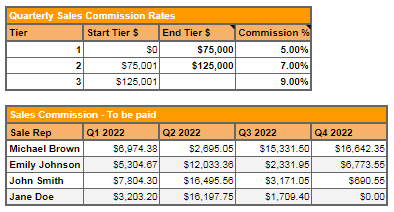
Tiered commission structures incentivize salespeople to surpass their sales goals by offering progressively higher commission rates for exceeding specific sales volumes. In this type of plan, commission percentages increase as salespeople reach predetermined benchmarks.
For example, a three-tiered plan might offer a 5% commission for sales up to $10,000, a 7% commission for sales between $10,001 and $20,000, and a top tier of 10% commission for sales exceeding $20,000. Let's say a salesperson achieves $25,000 in sales. They would earn a 5% commission on the first $10,000 ($500), followed by a 7% commission on the next $10,000 ($700), and finally a 10% commission on the remaining $5,000 ($500), resulting in a total commission of $1,700.
Residual Commission
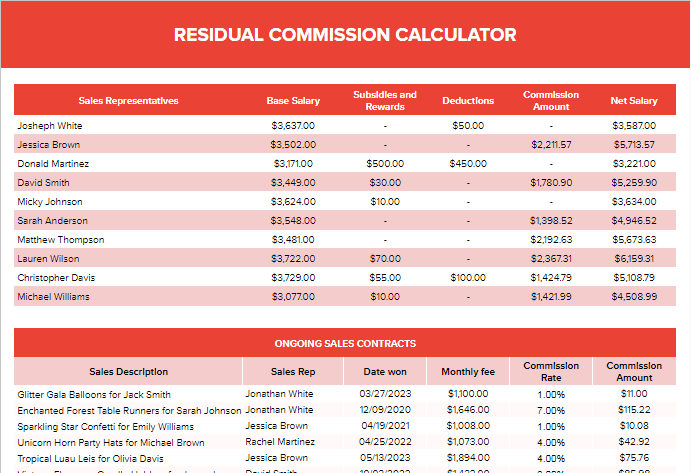
The revenue commission plan offers sales representatives a commission directly tied to the total sales they generate for the company. This structure fosters a strong correlation between an individual's sales efforts and their earning potential, as compensation is determined by the overall revenue they bring in.
For example, a salesperson selling $50,000 worth of products in a month with a 4% commission rate would earn $2,000 in commission for that month.
Revenue Commission
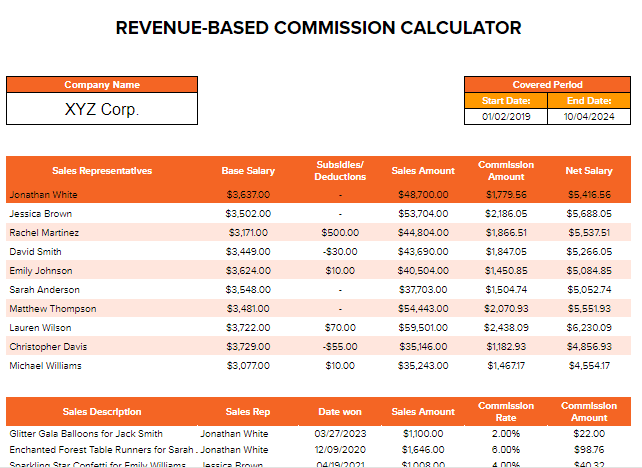
Revenue commission is a straightforward sales compensation plan that directly links a salesperson's earnings to the total amount of sales they generate for the company. Unlike commission structures based on profit margins or specific products sold, revenue commission focuses purely on the overall sales figure. This creates a clear alignment between a salesperson's efforts and their potential income: the more they sell, the higher their commission payout. This approach can be particularly motivating for salespeople, as their success is directly reflected in their paychecks.
Example: A salesperson with a 5% revenue commission on a $10,000 sale would earn $500 in commission.
Gross Margin Commission
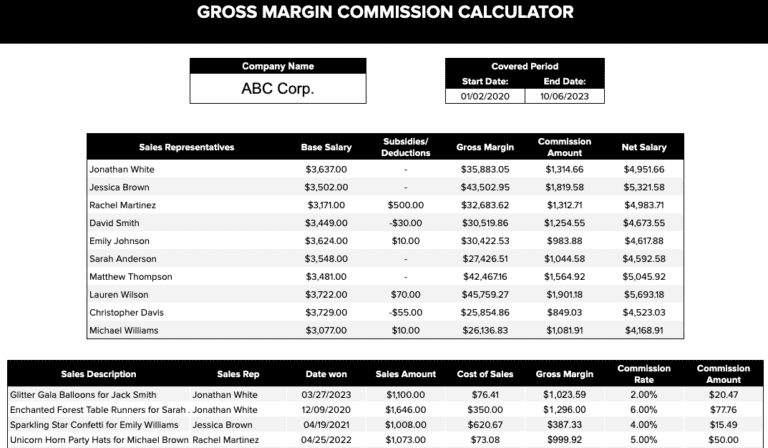
Gross margin commission is a sales compensation plan that rewards salespeople based on the profit a sale generates for the company, not just the total revenue. In other words, salespeople earn a commission on the difference between the selling price and the cost of the product.
Example: A salesperson with a 10% gross margin commission on a product with a $20 profit margin would earn $2 in commission.
Territory Volume Commission

Territory commission plans differ from traditional commission structures by focusing on the overall sales performance of a designated geographic area, rather than individual salesperson achievements. This approach incentivizes teamwork and collaboration within the sales team for a specific territory, like a region, state, or city. Essentially, all salespeople assigned to that territory contribute to a shared sales quota. Once the quota is met, or exceeded, the total commission earned is then divided amongst the team members, often equally.
This structure can be beneficial for fostering a collaborative sales environment, but it might not be ideal for recognizing and rewarding high-performing individual salespeople.
Example: If a sales team in the Eastern region collectively sells $1 million worth of products with a 5% commission rate, each salesperson would earn an equal share of the $50,000 commission pool.
Commission Only
Commission only is a high-risk, high-reward compensation plan where salespeople earn solely based on a percentage of their sales. There's no guaranteed income like a base salary, so success hinges entirely on their ability to close deals. This approach can motivate strong performers but offers no safety net and might not be ideal for beginners.
Example: A salesperson with a 15% commission rate selling $5,000 worth of products would earn $750 in commission for that sale. However, if they don't make any sales in a particular month, they won't receive any income.
Draw Against Commission
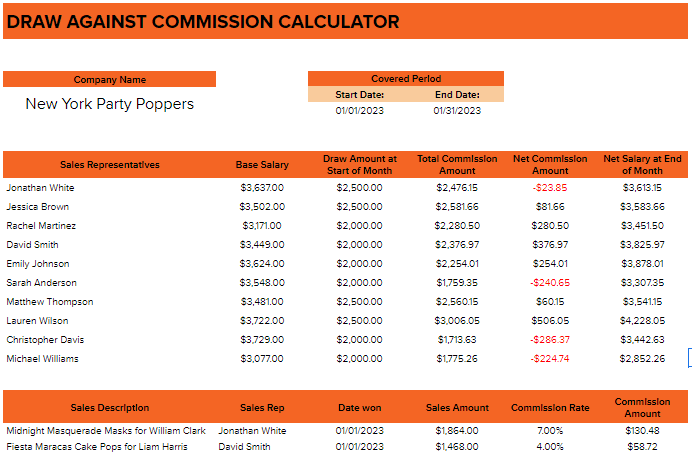
Draw against commission offers a safety net for salespeople in a commission-only structure. It essentially functions as an advance on their future earnings. Salespeople receive regular payments (the draw) throughout a pay period, which is then deducted from their total commissions earned at the end of that period. This provides some guaranteed income and helps with cash flow, particularly for those new to a sales role or facing a slow sales cycle. If their commissions exceed the draw amount, they keep the difference. However, it's important to note that any shortfall becomes a debt that needs to be repaid from future commissions. This plan can be beneficial for both salespeople and employers by offering some financial stability while still incentivizing sales performance.
Example: A salesperson receives a draw of $1,000 every two weeks, then at the end of the month, they repay the draw from their earned commissions and keep any remaining amount.
Conclusion
Crafting an effective sales manager compensation plan is a crucial element in driving sales success and motivating your sales team. By understanding the various plan structures, from base salary and commission to territory volume and drawing against commission, you can tailor a program that aligns with your company's goals, sales cycle, and target market. Remember, the ideal plan should incentivize desired sales behaviors, be clear and transparent for your team, and provide a fair balance between guaranteed income and potential for high earnings. Don't be afraid to experiment and adapt your plan over time to optimize its effectiveness. By carefully considering these factors and staying informed about the latest trends in sales compensation, you can equip your sales reps with the motivational foundation they need to excel and propel your company's sales growth.
Say Goodbye To Tedious Data Exports!
Are you tired of spending hours manually exporting CSVs from different tools and importing them into Google Sheets?
Superjoin is a data connector for Google Sheets that connects your favorite SaaS tools to Google Sheets automatically. You can get data from these platforms into Google Sheets automatically to build reports that update automatically.
Try Superjoin out for free or schedule a demo.
Motivating your sales team is crucial for achieving ambitious sales goals. A well-designed sales manager compensation plan is a powerful tool in your arsenal. It directly ties a sales manager's rewards to the performance of their team, fostering a strong sense of ownership and accountability. However, crafting an effective sales manager compensation plan can be a complex task. This guide will equip you with the knowledge and best practices to design a plan that incentivizes the right behaviors, drives results, and keeps your top talent engaged.
What is Sales Compensation?
Sales compensation refers to the total financial rewards a salesperson receives for their work. It's not just a fixed salary.
Sales Compensation Plans
Sales compensation plans are strategies businesses use to reward and motivate their sales teams to hit specific goals. These plans help ensure that sales efforts align with the company's overall objectives, promoting revenue growth and strategic success.
Components of the Sales Compensation Plan
Pay Mix:
This refers to the breakdown of an individual salesperson's total compensation package. It typically consists of two main components:
Base Salary: This provides a sense of financial security and attracts qualified candidates. It should be competitive within your industry and reflect the experience level of the position.
Variable Pay: This portion of the compensation is directly tied to performance and incentivizes exceeding sales goals. Common forms of variable pay include:
Commission: A percentage of the total sales revenue generated by the salesperson.
Bonus: A lump sum reward for achieving specific goals, such as exceeding quota, acquiring new clients, or demonstrating exceptional customer service.
The ideal mix of base salary and variable pay depends on several factors, including:
Industry Standards: Research what's typical within your industry for similar sales roles.
Sales Cycle Length: For longer sales cycles, a higher base salary might be appropriate to provide stability.
Desired Sales Behavior: A higher commission rate incentivizes reps to close more deals, while a bonus tied to specific metrics can encourage desired behaviors like upselling or customer retention.
Sales Performance Metrics:
These are the quantifiable measures used to determine a salesperson's performance and their eligibility for variable compensation. Common metrics include:
Quota Attainment: The baseline sales target assigned to each salesperson or team.
Revenue Generated: The total amount of sales brought in by the salesperson.
Number of Deals Closed: The quantity of sales successfully completed.
Average Deal Size: The average value of each closed deal.
Customer Acquisition Cost (CAC): The cost associated with acquiring a new customer.
Customer Lifetime Value (CLTV): The total revenue a customer is expected to generate over their relationship with the company.
The specific metrics you choose should align with your overall sales goals and the desired sales behaviors you want to incentivize.
Commission Structure:
This defines how salespeople earn commissions based on their performance. There are several common structures:
Straight Commission: Sales reps earn a fixed percentage of the total sales revenue they generate.
Tiered Commission: Commission rates increase as reps exceed specific sales targets, motivating them to push for higher performance.
Bonus on Top of Commission: A bonus is awarded on top of commission for achieving specific goals beyond just sales volume.
The ideal commission structure depends on the complexity of your sales process, the average deal size, and the level of control you want over sales rep activity.
Quota Setting:
Quotas are the specific sales targets assigned to individual salespeople or teams. Setting realistic yet challenging quotas is essential. Here are some key considerations:
Historical Sales Data: Analyze past performance to establish a baseline for setting quotas.
Market Trends: Factor in anticipated market shifts that could impact sales potential.
Sales Team Capability: Consider the skills and experience level of your salespeople when setting quotas.
Performance Tracking and Communication:
Regularly monitor and track the performance of your sales team against the established metrics and quotas. Transparent communication is key. Clearly explain the compensation plan to your salespeople and provide them with regular feedback on their progress. This helps them understand how their efforts translate into rewards and keeps them motivated.
In short, sales compensation is designed to be motivating. It links a salesperson's income directly to their performance and encourages them to achieve the company's sales goals.
Examples of Sales Compensation Plan
Feeling lost when it comes to crafting a sales compensation plan?
Don't worry, we've got you covered! This guide will explore various sales compensation structures, providing clear examples to help you navigate your options.
Base Pay
Base pay, also called base salary, is the foundational element of a salesperson's compensation. It's a fixed, regular amount they receive each pay period, regardless of their sales performance. This guaranteed income provides a layer of financial security and stability, particularly for salespeople in industries with fluctuating sales cycles.
For example: a salesperson might receive a base salary of $4,000 per month, with the opportunity to earn additional income through commissions on their sales.
Base Pay + Commission

Sales compensation plans that combine base salary and commission incentivize salespeople with additional income on top of their guaranteed regular pay. This translates to higher earnings directly tied to their sales performance.
For example, a salesperson earning a base salary of $3,000 monthly with a 5% commission rate would receive a $1,000 commission for achieving $20,000 in sales that month. This would bring their total earnings to $4,000.
Tiered Commission

Tiered commission structures incentivize salespeople to surpass their sales goals by offering progressively higher commission rates for exceeding specific sales volumes. In this type of plan, commission percentages increase as salespeople reach predetermined benchmarks.
For example, a three-tiered plan might offer a 5% commission for sales up to $10,000, a 7% commission for sales between $10,001 and $20,000, and a top tier of 10% commission for sales exceeding $20,000. Let's say a salesperson achieves $25,000 in sales. They would earn a 5% commission on the first $10,000 ($500), followed by a 7% commission on the next $10,000 ($700), and finally a 10% commission on the remaining $5,000 ($500), resulting in a total commission of $1,700.
Residual Commission

The revenue commission plan offers sales representatives a commission directly tied to the total sales they generate for the company. This structure fosters a strong correlation between an individual's sales efforts and their earning potential, as compensation is determined by the overall revenue they bring in.
For example, a salesperson selling $50,000 worth of products in a month with a 4% commission rate would earn $2,000 in commission for that month.
Revenue Commission

Revenue commission is a straightforward sales compensation plan that directly links a salesperson's earnings to the total amount of sales they generate for the company. Unlike commission structures based on profit margins or specific products sold, revenue commission focuses purely on the overall sales figure. This creates a clear alignment between a salesperson's efforts and their potential income: the more they sell, the higher their commission payout. This approach can be particularly motivating for salespeople, as their success is directly reflected in their paychecks.
Example: A salesperson with a 5% revenue commission on a $10,000 sale would earn $500 in commission.
Gross Margin Commission

Gross margin commission is a sales compensation plan that rewards salespeople based on the profit a sale generates for the company, not just the total revenue. In other words, salespeople earn a commission on the difference between the selling price and the cost of the product.
Example: A salesperson with a 10% gross margin commission on a product with a $20 profit margin would earn $2 in commission.
Territory Volume Commission

Territory commission plans differ from traditional commission structures by focusing on the overall sales performance of a designated geographic area, rather than individual salesperson achievements. This approach incentivizes teamwork and collaboration within the sales team for a specific territory, like a region, state, or city. Essentially, all salespeople assigned to that territory contribute to a shared sales quota. Once the quota is met, or exceeded, the total commission earned is then divided amongst the team members, often equally.
This structure can be beneficial for fostering a collaborative sales environment, but it might not be ideal for recognizing and rewarding high-performing individual salespeople.
Example: If a sales team in the Eastern region collectively sells $1 million worth of products with a 5% commission rate, each salesperson would earn an equal share of the $50,000 commission pool.
Commission Only
Commission only is a high-risk, high-reward compensation plan where salespeople earn solely based on a percentage of their sales. There's no guaranteed income like a base salary, so success hinges entirely on their ability to close deals. This approach can motivate strong performers but offers no safety net and might not be ideal for beginners.
Example: A salesperson with a 15% commission rate selling $5,000 worth of products would earn $750 in commission for that sale. However, if they don't make any sales in a particular month, they won't receive any income.
Draw Against Commission

Draw against commission offers a safety net for salespeople in a commission-only structure. It essentially functions as an advance on their future earnings. Salespeople receive regular payments (the draw) throughout a pay period, which is then deducted from their total commissions earned at the end of that period. This provides some guaranteed income and helps with cash flow, particularly for those new to a sales role or facing a slow sales cycle. If their commissions exceed the draw amount, they keep the difference. However, it's important to note that any shortfall becomes a debt that needs to be repaid from future commissions. This plan can be beneficial for both salespeople and employers by offering some financial stability while still incentivizing sales performance.
Example: A salesperson receives a draw of $1,000 every two weeks, then at the end of the month, they repay the draw from their earned commissions and keep any remaining amount.
Conclusion
Crafting an effective sales manager compensation plan is a crucial element in driving sales success and motivating your sales team. By understanding the various plan structures, from base salary and commission to territory volume and drawing against commission, you can tailor a program that aligns with your company's goals, sales cycle, and target market. Remember, the ideal plan should incentivize desired sales behaviors, be clear and transparent for your team, and provide a fair balance between guaranteed income and potential for high earnings. Don't be afraid to experiment and adapt your plan over time to optimize its effectiveness. By carefully considering these factors and staying informed about the latest trends in sales compensation, you can equip your sales reps with the motivational foundation they need to excel and propel your company's sales growth.
Say Goodbye To Tedious Data Exports!
Are you tired of spending hours manually exporting CSVs from different tools and importing them into Google Sheets?
Superjoin is a data connector for Google Sheets that connects your favorite SaaS tools to Google Sheets automatically. You can get data from these platforms into Google Sheets automatically to build reports that update automatically.
Try Superjoin out for free or schedule a demo.
FAQs
How can I motivate my sales team beyond just the sales manager compensation plan?
How can I motivate my sales team beyond just the sales manager compensation plan?
What can I do if my sales managers are unhappy with the current compensation plan?
What can I do if my sales managers are unhappy with the current compensation plan?
How can Superjoin help me manage my sales manager compensation plans?
How can Superjoin help me manage my sales manager compensation plans?
Automatic Data Pulls
Visual Data Preview
Set Alerts
Try it now
